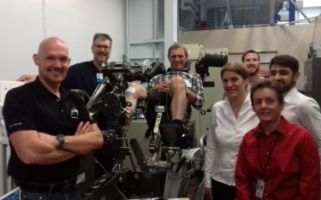SENER installs MARES training model at NASA's Johnson Space Center

The engineering and technology group SENER has installed a training model of the scientific instrument MARES (Muscle Atrophy Research and Exercise System) at the Space Vehicle Mock-Up Facility in the Johnson Space Center, NASA's center for manned space activities, located in Houston, Texas (USA). This is the fourth MARES model installed by SENER, having already set up another training model at the Gagarin Cosmonaut Training Center, GCTC , in Moscow, run by Russian space agency Roscosmos, and two flight models: one on the International Space Station (ISS) and another in CADMOS, at the National Center for Space Studies (CNES) in Toulouse (France). In this last center, SENER develops and tests, in conjunction with the CADMOS team, the experiments defined by the scientists for MARES, as well as monitoring from the control room when they are executed in the ISS.
MARES is a piece of equipment fully integrated by SENER for the European Space Agency (ESA), for researching the effects of zero gravity on the muscles in the human body. This project also forms part of the NASA Human Research Facility (HRF).
Thanks to the MARES models installed at the Johnson Space Center, in Roscosmos and in the ESA, cosmonauts can do assembly and usage tests for subsequent implementation in the ISS, and they can also carry out pre-flight and post-flight protocols for the joint experiment run by the European, US and Russian agencies - Sarcolab (Myotendinous and Neuromuscular Adaptation to Long-term Spaceflight), designed to assess muscle atrophy experienced by astronauts in the muscle groups of the knee and ankle joints.
ESA astronaut Thomas Pesquet, who returned to Earth in May 2017, was the first astronaut to complete the Sarcolab protocol with the MARES system in the ISS. During his six-month stay aboard the International Space Station, he did no physical exercise at all, thus allowing his body to experience the effects of muscular atrophy. So, when the MARES protocol was carried out, it was possible to measure the real effects of zero gravity on musculature. This information is being analyzed by scientists in order to propose ways to counteract the muscle atrophy caused by zero gravity, since it represents a serious handicap for long-term manned space missions, such as, future expeditions to Mars.
In order to expand and validate the data of this study, MARES is being used aboard the ISS by the astronauts of Expedition 53, Paolo Nespoli, of the ESA, and Randy Bresnik, of NASA. Both of these crew members, after remaining equally inactive in terms of physical exercise, are now completing the protocol on the ISS. When they return to Earth, they will continue with the post-flight protocol of the Sarcolab-3 experiment.
The MARES system designed by SENER enables muscle atrophy to be studied in both individual muscles of the torso and limbs and also groups of muscles in an entire limb. To monitor this, it applies a stimulus that is programmable in speed or in torque to eleven muscle groups in the human body, in order to subsequently measure the torque response and speed of the subject. Based on the results obtained, MARES will enable effective protocols to be established: the astronauts themselves will be able to monitor the effectiveness of the gym work while they are still in orbit. Furthermore, MARES is tasked with carrying out studies in muscular, neuromuscular and neurological physiology, providing information that may be useful in other areas such as medical and sports rehabilitation involving treatment of patients with muscular atrophy caused by paralysis, trauma or prolonged immobilization.
In 2017, SENER commemorates 50 years as a key player in the international space industry. To date, SENER has successfully handed over more than 275 systems and equipment for satellites and space vehicles for space agencies in the US (NASA), Europe (ESA), Japan (JAXA) and Russia (Roscosmos). SENER is the leading Spanish company in the European Space Agency's science programs through its engineering contributions; SENER has taken part in more than half of these missions.




